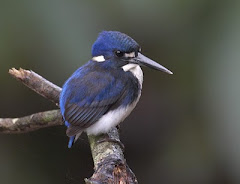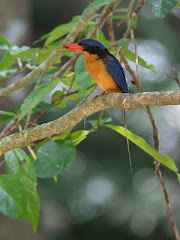A special week for all the birding businesses from the Bird Trails Tropical Queensland group in Tropical North Queensland, with a week's visit to the region from a group of international birdwatching journalists. We all had the opportunity to host them and, all in all, they had a fabulous time.
We decided that the 'Birding Journo Gods' were watching out for us when they arrived in Daintree. After a few days of miserable rain, the sun came out and so did the birds.
A quick drive to the end of Stewart Creek Rd gave us some of our best birds with Buff-breasted Paradise Kingfisher, Azure Kingfisher, Little Kingfisher, Yellow-breasted Boatbill, Victoria's Riflebird, Pied Monarch, Lovely Fairy-Wren, Cicadabird and many many more birds in feeding flocks, working their way through the forest. Couldn't get the grins off our faces!!
 |
| Hugh, Ed, Trish and Mike - Stewart Creek Rd |
All good, really!



